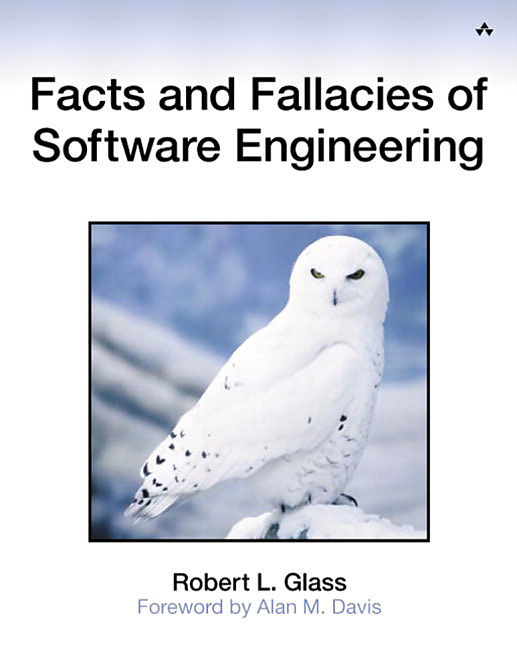Facts and Fallacies of Software Engineering
Einband:
Kartonierter Einband
EAN:
9780321117427
Untertitel:
Englisch
Genre:
Programmiersprachen
Autor:
Robert L. Glass
Herausgeber:
Pearson International
Auflage:
1. Auflage
Anzahl Seiten:
212
Erscheinungsdatum:
28.10.2002
ISBN:
0321117425
The practice of building software is a
Autorentext
Robert Glass is the founder of Computing Trends. He has written more than a dozen books on software engineering and on the lessons of computing failures. Robert is trusted by many as a leading authority on software engineering, especially by those who read his columns in Communications of the ACM and IEEE Software. Robert also publishes a newsletter, The Software Practitioner, and speaks frequently at software engineering events.
0321117425AB09232002
Klappentext
Controversial and thought-provoking! Many software professionals might disagree with the author's assessments, but all will embrace the debate. Identifies many of the key problems hampering success in this field. Each fact is supported by insightful discussion and detailed references. A lot of what software engineers ought to know about building software is, for whatever reason, not known (forgotten, neglected, never considered, etc.). This book is a collection of fifty-five facts that software engineers should always consider. The facts are fundamental. The facts are frequently forgotten. And above all, the facts are important to the success of a project. Robert Glass brings a lifetime's work in software engineering to this often-witty book. In his considerable experience, the author has witnessed that software engineers need to learn the same lessons over and over again. In formally presenting many of these key facts, he hopes that software builders can avoid many of the pitfalls that all too often plague a project. The book covers management, all stages of the software lifecycle, quality, research, and much more. The author even presents ten common fallacies that help support the fifty-five facts. Anyone with an interest in building better software can benefit from this thought-provoking new book. Robert L.Glass is a consultant on software quality issues who has written more than a dozen books on Software Engineering topics and on the lessons of computing failures, including Software Runaways: Monumental Software Disasters, and Computing Calamities. Glass owns his own company, Computing Trends, and writes a column on software engineering for two societal journals, Communications of the ACM and IEEE Software, and he publishes his own newsletter, The Software Practitioner. He is a frequent speaker at Software Engineering events.
Zusammenfassung
PLEASE PROVIDE SUMMARY
Inhalt
Acknowledgments.
Foreword.
I. 55 FACTS. Introduction. @CHAPTER 1. = About Management.
People. Fact 1. The most important factor in software work is the quality of the programmers. Fact 2. The best programmers are up to 28 times better than the worst programmers. Fact 3. Adding people to a late project makes it later. Fact 4. The working environment has a profound impact on productivity and quality. Tools and Techniques. Fact 5. Hype (about tools and techniques) is the plague on the house of software. Fact 6. New tools/techniques cause an initial loss of productivity/quality. Fact 7. Software developers talk a lot about tools, but seldom use them. Estimation. Fact 8. One of the two most common causes of runaway projects is poor estimation. Fact 9. Software estimation usually occurs at the wrong time. Fact 10. Software estimation is usually done by the wrong people. Fact 11. Software estimates are rarely corrected as the project proceeds. Fact 12. It is not surprising that software estimates are bad. But we live and die by them anyway! Fact 13. There is a disconnect between software management and their programmers. Fact 14. The answer to a feasibility study is almost always “yes”. Reuse. Fact 15. Reuse-in-the-small is a well-solved problem. Fact 16. Reuse-in-the-large remains a mostly unsolved problem. Fact 17. Reuse-in-the-large works best for families of related systems. Fact 18. Reusable components are three times as hard to build, and should be tried out in three settings. Fact 19. Modification of reused code is particularly error-prone. Fact 20. Design pattern reuse is one solution to the problems of code reuse. Complexity. Fact 21. For every 25 percent increase in problem complexity, there is a 100 percent increase in solution complexity. Fact 22. Eighty percent of software work is intellectual. A fair amount of it is creative. Little of it is clerical. 2. About the Life Cycle.
Requirements. Fact 23. One of the two most common causes of runaway projects is unstable requirements. Fact 24. Requirements errors are the most expensive to fix during production. Fact 25. Missing requirements are the hardest requirements errors to correct. Design. Fact 26. Explicit requirements “explode” as implicit (design) requirements for a solution evolve. Fact 27. There is seldom one best design solution to a software problem. Fact 28. Design is a complex, iterative process. Initial design solutions are usually wrong, and certainly not optimal. Coding. Fact 29. Designer “primitives” (solutions they can readily code) rarely match programmer “primitives”. Fact 30. COBOL is a very bad language, but all the others (for business applications) are so much worse. Error-removal. Fact 31. Error-removal is the most time-consuming phase of the life cycle. Testing. Fact 32. Software is usually tested at best at the 55-60 percent (branch) coverage level. Fact 33. 100 percent coverage is still far from enough. Fact 34. Test tools are essential, but many are rarely used. Fact 35. Test automation rarely is. Most testing activities cannot b…

Leider konnten wir für diesen Artikel keine Preise ermitteln ...
billigbuch.ch sucht jetzt für Sie die besten Angebote ...
Die aktuellen Verkaufspreise von 6 Onlineshops werden in Realtime abgefragt.
Sie können das gewünschte Produkt anschliessend direkt beim Anbieter Ihrer Wahl bestellen.
Loading...
Die aktuellen Verkaufspreise von 6 Onlineshops werden in Realtime abgefragt.
Sie können das gewünschte Produkt anschliessend direkt beim Anbieter Ihrer Wahl bestellen.
| # | Onlineshop | Preis CHF | Versand CHF | Total CHF | ||
|---|---|---|---|---|---|---|
| 1 | Seller | 0.00 | 0.00 | 0.00 |
